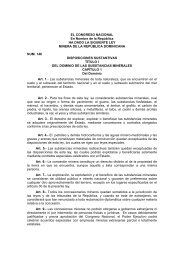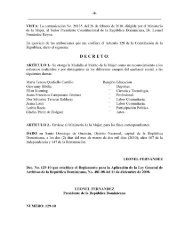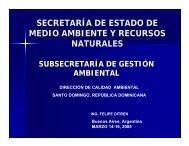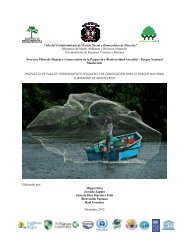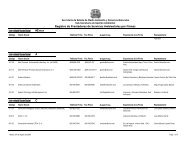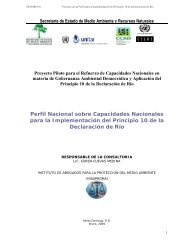CAMBIO CLIMATICO
CAMBIO CLIMATICO
CAMBIO CLIMATICO
Create successful ePaper yourself
Turn your PDF publications into a flip-book with our unique Google optimized e-Paper software.
REPÚBLICA DOMINICANA 2003<br />
The context of the study was developed with the<br />
creation of climatic scenarios, based on general<br />
circulation models and on MAGICC and SCEN-<br />
GEN software models adapted to the data from<br />
the climatic data of the country and applied to<br />
the above mentioned sectors.<br />
An analysis of climatic conditions was conducted<br />
from the period 1961-1990, developing the<br />
climatic baseline of the country in a simulation<br />
of the future climate of the Dominican Republic.<br />
In addition, the representation method was<br />
used, for which it was necessary to design a<br />
combination of emission scenarios and General<br />
Circulation Models (GCMs) that would allow for<br />
the consideration of the greatest possible level of<br />
uncertainty.<br />
This gave way to the availability of various scenarios<br />
for evaluating vulnerability in the different<br />
sectors, with a temporary time horizon that<br />
includes four periods: 2010, 2030, 2050, and<br />
2100, with the goal of evaluating conditions in<br />
the near future so as to sensitize decision makers<br />
and, in turn, to evaluate at such late dates as<br />
2100, and to measure the scope of the impacts.<br />
1.4.1 Water Sector<br />
1.4.1.a) Water Balance for Climate<br />
Change Scenarios<br />
Following are the results of some considerations<br />
regarding the water balance for the climatic<br />
scenarios designed with the CSRT models<br />
(emission scenario IS92c), ECH4 (emission scenario<br />
IS92a) and HADM2 (emission scenario<br />
IS92f). In referring to the emission scenarios,<br />
Limia (personal communication, 2001) notes<br />
the following: (sic)<br />
1.4.1.b) Water Balance Results<br />
for Each Scenario<br />
The CSRT Model estimates a warming over the<br />
next 100 years on the order of 0.7° C and a 4%<br />
increase in rainfall. Although the evaporating<br />
capacity of the atmosphere and real evapotranspiration<br />
increase, the behavior of the rainfall is<br />
sufficient to increase the total runoff.<br />
The ECH4 Model shows an increase of 2.6° C in<br />
temperature and a decrease in pluvial activity<br />
on the order of 10% over the next hundred<br />
years. For this reason, the values of potential<br />
evaporation and real evapotranspiration will<br />
increase, and the total volume of available<br />
water in the country will decrease by 28% with<br />
respect to the baseline.<br />
The HADCM2 Model demonstrates the most<br />
dramatic foreseeable scenario regarding the<br />
availability of water if a significant reduction<br />
in the emission of thermoactive gases is not<br />
achieved. In this climate scenario, there is an<br />
increase in temperature of 4.2° C and a<br />
decrease in rainfall of approximately 60% over<br />
the next 100 years. Consequently, the total volume<br />
of runoff will be reduced by 95% for the<br />
year 2100. The critical situation described in<br />
this model coincides with the results obtained<br />
by the Meteorological Office of the United<br />
Kingdom in 1998, when it noted that the<br />
Eastern Caribbean will be the most arid zone of<br />
any of the scenarios that are modeled.<br />
To have an idea of the impact of this climate<br />
scenario on water resources, spatial distribution<br />
of rainfall, and total runoff for the year<br />
2100, a great decrease in the value of these<br />
variables is observed, demonstrating a structural<br />
change that intensifies the transition<br />
from the most humid zones to the driest and an<br />
expansion of the areas of the country that are<br />
historically the driest.<br />
If one considers that the average population<br />
growth rate (2.31 according to the National<br />
Statistics Office, cited by the UNDP, 2000) will<br />
hold steady during the present century, and if it<br />
is assumed that the current exploitation of water<br />
resources will remain constant (around 3 billion<br />
m3 of water annually), the proposed hydrological<br />
scenarios could be more severe if measures<br />
aimed at a more rational use of water – including<br />
its protection - are not adopted.<br />
44



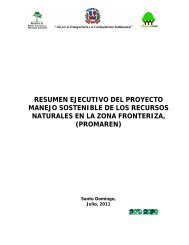
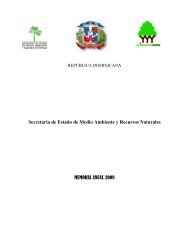

![Documento de trabajo del grupo G-77[1] EconomÃa verde en el ...](https://img.yumpu.com/50859069/1/190x245/documento-de-trabajo-del-grupo-g-771-economa-a-verde-en-el-.jpg?quality=85)




